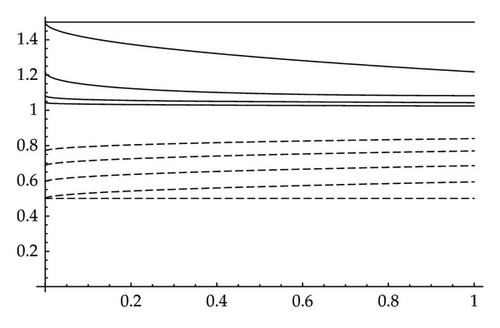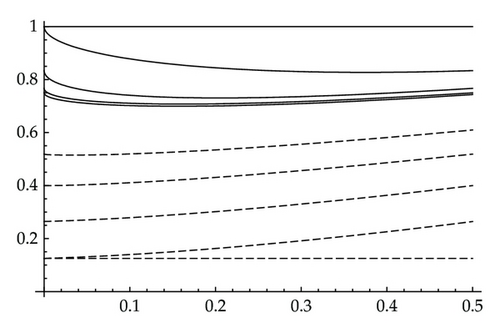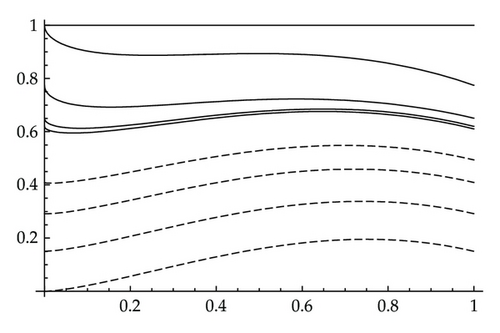Generalized Monotone Iterative Technique for Caputo Fractional Differential Equation with Periodic Boundary Condition via Initial Value Problem
Abstract
We develop a generalized monotone method using coupled lower and upper solutions for Caputo fractional differential equations with periodic boundary conditions of order q, where 0 < q < 1. We develop results which provide natural monotone sequences or intertwined monotone sequences which converge uniformly and monotonically to coupled minimal and maximal periodic solutions. However, these monotone iterates are solutions of linear initial value problems which are easier to compute.
1. Introduction
The study of fractional differential equations has acquired popularity in the last few decades due to its multiple applications, see [1–5] for more information. However, it was not until recently that a study on the existence of solutions by using upper and lower solutions, which is well established for ordinary differential equations in [6], has been done for fractional differential equations. See [3, 7–16] for recent work.
In this paper we recall a comparison theorem from [3] for a Caputo fractional differential equation of order q, 0 < q < 1, with initial condition. We will use coupled lower and upper solutions combined with a generalized monotone method of initial value problems to prove the existence of coupled minimal and maximal periodic solutions. The results developed provide natural sequences and intertwined sequences which converge uniformly and monotonically to coupled minimal and maximal periodic solutions. Instead of the usual approach as in [6, 17] where the iterates are solutions of linear periodic boundary value problems we have used a generalized monotone method of initial value problems. This idea was presented in [18] for integrodifferential equations. The advantage of this method, compared to what was developed in [3, 15], is that it avoids computing the solution of the linear periodic boundary value problem using the Mittag-Leffler function at every step of the iterates. We also modify the comparison theorem which does not require the Hölder continuity condition as in [3].
2. Preliminary Definitions and Comparison Results
In this paper we will denote .
Throughout this paper we consider the Caputo derivative of order q, for 0 < q < 1 and t ∈ [0,1]. We start by showing some comparison results relative to initial value problems with the Caputo fractional derivative of order q.
Lemma 2.1. Let m(t) ∈ C1([0, T], ℝ). If there exists t1 ∈ [0, T] such that m(t1) = 0 and m(t) ≤ 0 on [0, T], then it follows that
Proof. Let t1 ∈ [0, T], the using the relation (2.3) we have that
Since this lemma was proven in [8] for the Riemann Liouville derivative, we have that Dqm(t1) ≥ 0 implies , and the proof is complete.
Remark 2.2. In [3] they proved the above result by assuming that m(t) is Hölder continuous of order λ > q. Although the proof is correct, it is not useful in the monotone method or any iterative method because we will not be able to prove that each of those iterates are Hölder continuous of order λ > q.
Now we are ready to establish the following comparison theorem.
Theorem 2.3. Let J = [0, T], f ∈ C[J × ℝ, ℝ], v, w ∈ C1[J, ℝ], and for t ∈ J the following inequalities hold true,
Suppose further that f(t, u) satisfies the following Lipschitz condition,
Proof. Assume first without loss of generality that one of the inequalities in (2.6) is strict, say , and v0 < w0, where v(0) = v0 and w(0) = w0. We will show that v(t) < w(t) for t ∈ J.
Suppose, to the contrary, that there exists t1 such that 0 < t1 ≤ T for which
Setting m(t) = v(t) − w(t) it follows that m(t1) = 0 and m(t) ≤ 0 for t < t1. Then by hypothesis and Lemma 2.1 we have that cDqm(t1) ≥ 0. Thus
Now assume that the inequalities (2.6) are nonstrict. We will show that v(t) ≤ w(t).
Set wϵ(t) = w(t) + ϵλ(t), where ϵ > 0 and λ(t) = Eq[2Ltq], where Eq is the one parameter Mittag-Leffler function. This implies that wϵ(0) = w0 + ϵ > w0 and wϵ(t) > w(t) for t ∈ (0, T].
Using (2.6) and the Lipschitz condition (2.7), we find that
Here we have utilized the fact that λ(t) is the solution of the initial value problem
Clearly there is no assumption on the growth of L > 0. Applying now the result for strict inequalities to v(t), wϵ(t), we get that v(t) < wϵ(t) for t ∈ J, for every ϵ > 0 and consequently making ϵ → 0, we get that v(t) ≤ w(t) for t ∈ J.
The following corollary will be useful in our main results.
Corollary 2.4. Let m ∈ C1[J, ℝ] be such that
Then we have from the previous theorem the estimate
The result of the above corollary is still true even if L = 0, which we state separately and prove it.
Corollary 2.5. Let cDqm(t) ≤ 0 on [0, T]. Then m(t) ≤ 0, if m(0) ≤ 0.
Proof. By definition of cDqm(t) and by hypothesis,
Note that the above result may not be true for the Riemann Liouville derivative.
We recall a comparison result from [3] for periodic boundary conditions. As in Theorem 2.3, the proof does not require Hölder continuity.
Theorem 2.6. Let J = [0, T], f ∈ C[J × ℝ, ℝ], v, w ∈ C1[J, ℝ], and for 0 < t ≤ T,
Suppose further that f(t, u) is strictly decreasing in u for each t, then
Proof. If the conclusion is not true; that is, if there exists t0 ∈ [0, T] such that v(t0) > w(t0), then there exists an ε > 0 such that
Setting m(t) = v(t) − w(t) − ε we find that if t0 ∈ (0, T], then
By Lemma 2.1 we have that cDqm(t0) ≥ 0. Thus, cDqv(t0) ≥ cDqw(t0). We now obtain by hypothesis and by the strictly decreasing nature of f(t, u) in u,
If t0 = 0, then
Hence v(t) ≤ w(t) for 0 ≤ t ≤ T and the proof is complete.
Two important cases of this theorem are the following which are useful to prove the uniqueness of the solution of a Caputo fractional differential equation with periodic boundary conditions.
Corollary 2.7. Let m ∈ C1[J, ℝ] be such that
Similarly, if
Remark 2.8. It is to be noted that in the proof of these equivalent results from [3] we use Lemma 2.1 which does not require the Hölder continuity assumption.
This poses a problem to compute the linear iterates since it involves Mittag-Leffler functions. The advantage of our method is that it does not require the Mittag-Leffler function in our computations.
Pandit et al. used the initial value problem to obtain a generalized monotone method in [18] for nonlinear integrodifferential equations with periodic boundary conditions. In the next section we develop a monotone method using this idea.
3. Generalized Monotone Method for the Nonlinear Periodic Boundary Value Problem via Initial Value Problem
Furthermore, throughout this paper, we will assume that f is increasing in u and g is decreasing in u for t ∈ J.
Here below we provide the definition of coupled lower and upper solutions of (3.2).
Definition 3.1. Let v0, w0 ∈ C1[J, ℝ]. Then v0 and w0 are said to be,
We will state the following four theorems related to coupled lower and upper solutions of Type I and Type II, respectively. We develop the generalized monotone method for the periodic boundary value problem via the initial value problem approach. We obtain natural sequences and intertwined sequences which converge uniformly and monotonically to coupled minimal and maximal periodic solutions of (3.2).
In the next theorem, we use coupled lower and upper solutions of Type I and obtain natural sequences which converge uniformly and monotonically to coupled minimal and maximal periodic solutions of (3.2).
Theorem 3.2. Assume that
- (A1)
v0, w0 are coupled lower and upper solutions of Type I for (3.2) with v0(t) ≤ u(t) ≤ w0(t) on J;
- (A2)
f, g ∈ C[J × ℝ, ℝ], f(t, u(t)) is increasing in u and g(t, u(t)) is decreasing in u.
Then the sequences defined by
Proof. By hypothesis, v0 ≤ u ≤ w0. We will show that v0 ≤ v1 ≤ u ≤ w1 ≤ w0.
It follows from (3.5) that
Therefore, v0(0) ≤ v0(T) = v1(0). If we let p = v0 − v1, then p(0) ≤ 0 and,
Since cDqp ≤ 0 and p(0) ≤ 0, by Corollary 2.5 we have that p(t) ≤ 0 and, consequently, v0(t) ≤ v1(t) on J. By a similar argument we can show that v1(t) ≤ u, u ≤ w1(t), and w1(t) ≤ w0(t). Thus, v0 ≤ v1 ≤ u ≤ w1 ≤ w0.
Now we will show that vk ≤ vk+1 for k ≥ 1.
Assume that
Let p = vk − vk+1. Then
Similarly, by Corollary 2.5 we have that p(t) ≤ 0 and consequently vk(t) ≤ vk+1(t).
By a similar argument we can show that wk+1 ≤ wk. Using the hypothesis that v0(t) ≤ u(t) ≤ w0(t) on J, the above argument and induction we can show that vk+1 ≤ u ≤ wk+1. Therefore for n > 1,
Now we have to show that the sequences converge uniformly. We will use Arzela-Ascoli theorem by showing that the sequences are uniformly bounded and equicontinuous.
First we show uniform boundedness. By hypothesis both v0(t) and w0(t) are bounded on [0, T], then there exists M > 0 such that for any t ∈ [0, T], |v0(t)| ≤ M, and |w0(t)| ≤ M. Since v0(t) ≤ vn(t) ≤ w0(t) for each n > 0, it follows that
To prove that {vn(t)} is equicontinuous, let 0 ≤ t1 ≤ t2 ≤ T. Then for n > 0,
Since {vn(t)} and {wn(t)} are uniformly bounded and f(t, u(t)) and g(t, u(t)) are continuous on [0, T], there exists independent of n such that
Thus, for any ε > 0 there exists δ > 0 independent of n such that for each n,
Similarly we can prove that {wn(t)} is equicontinuous and uniformly bounded.
This proves that {vn(t)} and {wn(t)} are uniformly bounded and equicontinuous on [0, T]. Hence by Arzela-Ascoli’s theorem there exist subsequences and which converge uniformly to ρ(t) and r(t), respectively. Since the sequences are monotone, the entire sequences converge uniformly.
We have shown that the sequences converge in C[0, T]. In order to show that they converge in C1[0, T], observe that since each vn is constructed as follows
Taking limits when n → ∞, we obtain by the Lebesgue dominated convergence theorem that
Hence vn(t) → ρ(t) in C1[0, T]. Furthermore, the above expression is equivalent to
By a similar argument wn(t) → r(t) in C1[0, T] and it can be shown that
Since vn ≤ u ≤ wn on [0, T] for all n, we get that ρ ≤ u ≤ r on [0, T] which shows that ρ and r are minimal and maximal periodic solutions of (3.2), respectively. This completes the proof.
Remark 3.3. In [3] the uniqueness is shown by making additional assumptions to Theorem 3.2 and using Corollary 2.7. However the iterates are solutions of the form (2.25). In our result, we have proved the existence of coupled minimal and maximal periodic solutions of (3.2), in particular if g ≡ 0 we get minimal and maximal periodic solutions of (3.2).
The next result also uses coupled upper and lower solutions of Type I. However, we obtain intertwined sequences which converge to coupled minimal and maximal periodic solutions of (3.2). The proof is similar to Theorem 3.2, hence we do not provide the proof.
Theorem 3.4. Assume that conditions (A1) and (A2) of Theorem 3.2 are true. Then the iterative scheme given by
Furthermore {v2n, w2n+1} → ρ and {v2n+1, w2n} → r in C1[J, ℝ], where ρ and r are coupled minimal and maximal periodic solutions of (3.2), respectively; that is, if v0 ≤ u ≤ w0 then ρ ≤ u ≤ r, and ρ and r satisfy the coupled system
In the previous two theorems we assumed the existence of coupled lower and upper solutions of type I. We can state two more results involving coupled lower and upper solutions of Type II, however they require an additional assumption in order to obtain natural or intertwined sequences converging to coupled minimal and maximal periodic solutions of problem (3.2).
Theorem 3.5. Assume that
- (B1)
v0 and w0 are coupled lower and upper solutions of Type II for (3.2) with v0(t) ≤ w0(t) on J,
- (B2)
f, g ∈ C[J × ℝ, ℝ], f(t, u(t)) is increasing in u, and g(t, u(t)) is decreasing in u.
If u(t) is a solution of (3.2) such that v0(t) ≤ u(t) ≤ w0(t). Then the sequences defined by (3.27) give alternating monotone sequences {v2n, w2n+1} and {v2n+1, w2n} satisfying
Furthermore {v2n, w2n+1} → ρ and {v2n+1, w2n} → r in C1[J, ℝ], where ρ and r are coupled minimal and maximal solutions of (3.2), respectively; that is, if v0 ≤ u ≤ w0 then ρ ≤ u ≤ r, and ρ and r satisfy the coupled system
Theorem 3.6. Assume that conditions (B1) and (B2) of Theorem 3.5 are true. Then the sequences defined by (3.8) and (3.9) are such that vn(t) → ρ(t) and wn(t) → r(t) in C1[J, ℝ] uniformly and monotonically, provided that v0 ≤ v1 ≤ u ≤ w1 ≤ w0, where ρ and r are coupled minimal and maximal solutions of (3.2), respectively; that is, ρ ≤ u ≤ r and ρ and r satisfy the coupled system
4. Numerical Examples
In this section we present some numerical examples which are application of Theorem 3.5.
Example 4.1. Consider the problem
Clearly u ≡ 0 and u ≡ 1 are solutions of the equation.
Since H(u) = u − u2 is increasing in u for u ≤ 0.5 and decreasing for u ≥ 0.5, we let
We construct our sequences according to Theorem 3.5 and show graphically in Figure 1 that {w2n, v2n+1} → 1.

Example 4.2. Consider the problem
Since H(t, u) = (u/8)−(u2/2)+(t/2) is increasing in u for u ≤ 0.125 and decreasing for u ≥ 0.125, we let
Using Theorem 3.5 we show in Figure 2 four steps of {v2n, w2n+1} and four steps of {w2n, v2n+1}. Observe that {w2n, v2n+1} converges more quickly to the periodic solution.

Example 4.3. Consider
Since f(t, u) = −(u2/2) + t(1 − t) is increasing in u for u ≤ 0 and decreasing for u ≥ 0,
Once again using Theorem 3.5 we computed in Figure 3 four steps of {v2n, w2n+1} and 4 steps of {w2n, v2n+1}. As in the previous examples {w2n, v2n+1} converges more quickly to the periodic solution.

5. Concluding Remarks
In our main results as well as in our numerical results we have not used the assumption needed to obtain unique solution of (3.2). If we make appropriate uniqueness assumption on the nonlinear terms f(t, u) and g(t, u) then our linear iterates will require the computation of the Mittag-Leffler function. We plan to take up this work in the near future.




